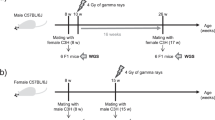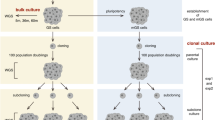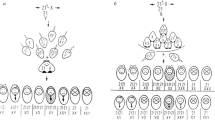Abstract
SPERMATOGONIA, as stem cells of male gametes1,2, constitute a highly relevant system for studying the genetic hazards of potential mutagens. Gross chromosome aberrations in spermatogonia have been used as a gauge of the genetic damage induced in animals exposed to agents such as mitomycin C (refs 3–5). Sister chromatid exchanges (SCEs) formed in response to DNA damage constitute even more sensitive indices of the impact of alkylating agents and other clastogens on chromosomes6–8. Analysis of SCE induction in cultured cells has been greatly facilitated by techniques in which substitution of DNA with the base analogue 5-bromodeoxyuridine (BUdR) is detected either with fluorescent dyes9,10 or by modified Giemsa procedures11–13. This approach has so far been limited to in vitro trials, with the exception of one system14 in which SCEs were visualised in chromosomes of chick embryos after exposure to BUdR in ovo. We report here a BUdR technique which enables the detection of SCEs formed in spermatogonial cells of intact mice. As a prototype of a general in vivo mutagenesis test, this procedure has been utilised to demonstrate a several-fold increase in the sister chromatid exchange frequency in mouse spermatogonia after injection of the animals with small amounts of mitomycin C.
This is a preview of subscription content, access via your institution
Access options
Subscribe to this journal
Receive 51 print issues and online access
$199.00 per year
only $3.90 per issue
Buy this article
- Purchase on Springer Link
- Instant access to full article PDF
Prices may be subject to local taxes which are calculated during checkout
Similar content being viewed by others
References
Oakberg, E. F., Mutat. Res, 11, 1–7 (1971).
Clermont, Y., Physiol. Rev., 52, 198–236 (1972).
Manyak, A., and Schleiermacher, E., Mutat. Res., 19, 99–108 (1973).
Adler, I., Mutat. Res., 23, 369–379 (1974).
Bempong, M. A., and Trower, E. C., J. Hered., 66, 285–289 (1975).
Kato, H., Expl Cell Res., 85, 239–247 (1974).
Latt, S. A., Proc. natn. Acad. Sci. U.S.A., 71, 3162–3166 (1974).
Perry, P., and Evans, H. J., Nature, 258, 121–125 (1975).
Latt, S. A., Proc. natn. Acad. Sci. U.S.A., 70, 3395–3399 (1973).
Kato, H., Nature, 251, 70–72 (1974).
Perry, P., and Wolff, S., Nature, 251, 156–158 (1974).
Kim, M. A., Humangenetik, 25, 179–188 (1974).
Korenberg, J., and Freedlender, E., Chromosoma, 48, 355–360 (1974).
Bloom, S. E., and Hsu, T. C., Chromosoma, 51, 261–267 (1975).
Meuth, M., and Green, H., Cell, 2, 109–112 (1974).
Russev, G., and Tsanev, R., Methods in Cell Biology, IX (edit. by Prescott, D. M.), ch. 8 (Academic, New York, 1975).
Monesi, V., J. Cell Biol., 14, 1–18 (1962).
Meredith, R., Chromosoma, 26, 254–258 (1969).
Latt, S. A., J. Histochem. Cytochem., 22, 478–491 (1974).
Latt, S. A., Science, 185, 74–76 (1974).
Lin, M. S., and Davidson, R. L., Science, 185, 1179–1181 (1974).
Dym, M., and Fawcett, D. W., Biol. Reprod., 4, 195–215 (1971).
Gilliavod, N., and Leonard, A., Mutat. Res., 13, 274–275 (1971).
Legator, M. S., and Malling, H. V., Chemical Mutagens, 2 (edit. by Hollaender, A.), ch. 22 (Plenum, New York, 1971).
Ames, B. N., McCann, J., and Yamasaki, E., Mutat. Res., 31, 347–364 (1975).
Vitale, R., Fawcett, D. W., and Dym, M., Anat. Res., 176, 333–344 (1973).
Ehling, U. H., Mutat. Res., 26, 285–295 (1974).
Heddle, J. A., and Bodycote, D. J., Mutat. Res., 9, 117–126 (1970).
Kofman-Alfaro, S., and Chandley, A. C., Chromosoma, 31, 404–420 (1970).
Author information
Authors and Affiliations
Rights and permissions
About this article
Cite this article
ALLEN, J., LATT, S. Analysis of sister chromatid exchange formation in vivo in mouse spermatogonia as a new test system for environmental mutagens. Nature 260, 449–451 (1976). https://doi.org/10.1038/260449a0
Received:
Accepted:
Issue Date:
DOI: https://doi.org/10.1038/260449a0
This article is cited by
-
BAIT: Organizing genomes and mapping rearrangements in single cells
Genome Medicine (2013)
-
DNA template strand sequencing of single-cells maps genomic rearrangements at high resolution
Nature Methods (2012)
-
Chromosome orientation fluorescence in situ hybridization to study sister chromatid segregation in vivo
Nature Protocols (2010)
-
High frequency of unequal recombination in pseudoautosomal region shown by proviral insertion in transgenic mouse
Nature (1986)
Comments
By submitting a comment you agree to abide by our Terms and Community Guidelines. If you find something abusive or that does not comply with our terms or guidelines please flag it as inappropriate.



